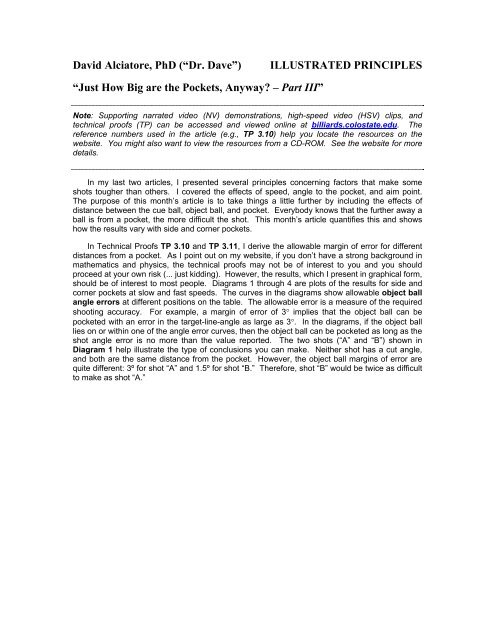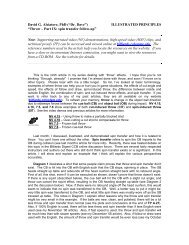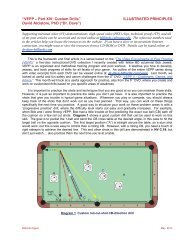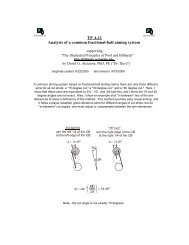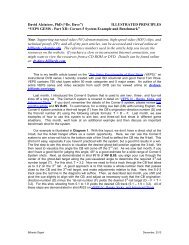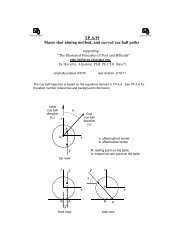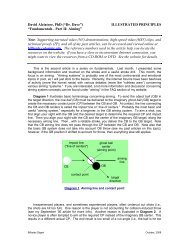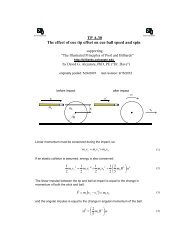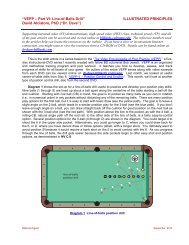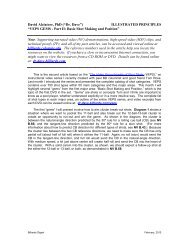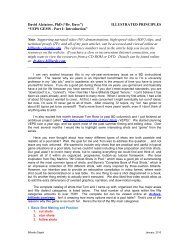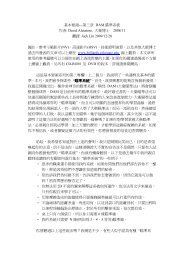Just How Big are the Pockets, Anyway - Illustrated Principles of Pool ...
Just How Big are the Pockets, Anyway - Illustrated Principles of Pool ...
Just How Big are the Pockets, Anyway - Illustrated Principles of Pool ...
You also want an ePaper? Increase the reach of your titles
YUMPU automatically turns print PDFs into web optimized ePapers that Google loves.
David Alciatore, PhD (“Dr. Dave”) ILLUSTRATED PRINCIPLES<br />
“<strong>Just</strong> <strong>How</strong> <strong>Big</strong> <strong>are</strong> <strong>the</strong> <strong>Pockets</strong>, <strong>Anyway</strong>? – Part III”<br />
Note: Supporting narrated video (NV) demonstrations, high-speed video (HSV) clips, and<br />
technical pro<strong>of</strong>s (TP) can be accessed and viewed online at billiards.colostate.edu. The<br />
reference numbers used in <strong>the</strong> article (e.g., TP 3.10) help you locate <strong>the</strong> resources on <strong>the</strong><br />
website. You might also want to view <strong>the</strong> resources from a CD-ROM. See <strong>the</strong> website for more<br />
details.<br />
In my last two articles, I presented several principles concerning factors that make some<br />
shots tougher than o<strong>the</strong>rs. I covered <strong>the</strong> effects <strong>of</strong> speed, angle to <strong>the</strong> pocket, and aim point.<br />
The purpose <strong>of</strong> this month’s article is to take things a little fur<strong>the</strong>r by including <strong>the</strong> effects <strong>of</strong><br />
distance between <strong>the</strong> cue ball, object ball, and pocket. Everybody knows that <strong>the</strong> fur<strong>the</strong>r away a<br />
ball is from a pocket, <strong>the</strong> more difficult <strong>the</strong> shot. This month’s article quantifies this and shows<br />
how <strong>the</strong> results vary with side and corner pockets.<br />
In Technical Pro<strong>of</strong>s TP 3.10 and TP 3.11, I derive <strong>the</strong> allowable margin <strong>of</strong> error for different<br />
distances from a pocket. As I point out on my website, if you don’t have a strong background in<br />
ma<strong>the</strong>matics and physics, <strong>the</strong> technical pro<strong>of</strong>s may not be <strong>of</strong> interest to you and you should<br />
proceed at your own risk (... just kidding). <strong>How</strong>ever, <strong>the</strong> results, which I present in graphical form,<br />
should be <strong>of</strong> interest to most people. Diagrams 1 through 4 <strong>are</strong> plots <strong>of</strong> <strong>the</strong> results for side and<br />
corner pockets at slow and fast speeds. The curves in <strong>the</strong> diagrams show allowable object ball<br />
angle errors at different positions on <strong>the</strong> table. The allowable error is a measure <strong>of</strong> <strong>the</strong> required<br />
shooting accuracy. For example, a margin <strong>of</strong> error <strong>of</strong> 3° implies that <strong>the</strong> object ball can be<br />
pocketed with an error in <strong>the</strong> target-line-angle as large as 3°. In <strong>the</strong> diagrams, if <strong>the</strong> object ball<br />
lies on or within one <strong>of</strong> <strong>the</strong> angle error curves, <strong>the</strong>n <strong>the</strong> object ball can be pocketed as long as <strong>the</strong><br />
shot angle error is no more than <strong>the</strong> value reported. The two shots (“A” and “B”) shown in<br />
Diagram 1 help illustrate <strong>the</strong> type <strong>of</strong> conclusions you can make. Nei<strong>the</strong>r shot has a cut angle,<br />
and both <strong>are</strong> <strong>the</strong> same distance from <strong>the</strong> pocket. <strong>How</strong>ever, <strong>the</strong> object ball margins <strong>of</strong> error <strong>are</strong><br />
quite different: 3º for shot “A” and 1.5º for shot “B.” Therefore, shot “B” would be twice as difficult<br />
to make as shot “A.”
technical pro<strong>of</strong><br />
fast<br />
medium<br />
slow<br />
B<br />
allowable<br />
object ball<br />
angle error<br />
1.5°<br />
2°<br />
3°<br />
Diagram 1 Side pocket margin <strong>of</strong> error regions for a slow shot<br />
fast<br />
medium<br />
slow<br />
allowable<br />
object ball<br />
angle error<br />
1.5°<br />
Diagram 2 Corner pocket margin <strong>of</strong> error regions for a slow shot<br />
TP 3.10 – Pocket margin <strong>of</strong> error regions for a slow shot<br />
A<br />
2°<br />
3°
technical pro<strong>of</strong><br />
fast<br />
medium<br />
slow<br />
allowable<br />
object ball<br />
angle error<br />
1.5°<br />
2°<br />
3°<br />
Diagram 3 Side pocket margin <strong>of</strong> error regions for a fast shot<br />
fast<br />
medium<br />
slow<br />
allowable<br />
object ball<br />
angle error<br />
1.5°<br />
Diagram 4 Corner pocket margin <strong>of</strong> error regions for a fast shot<br />
TP 3.11 – Pocket margin <strong>of</strong> error regions for a fast shot<br />
Diagrams 5 and 6 illustrate how Diagrams 1 through 4 can be useful in helping you<br />
understand shot selection. Diagram 5 shows two different object ball positions, both <strong>of</strong> which<br />
have <strong>the</strong> same cut angle and distance to <strong>the</strong> corner pocket. The question is which shot would be<br />
easier, assuming that ei<strong>the</strong>r shot would create equally good position for <strong>the</strong> next shot (and<br />
assuming you can avoid a scratch with shot “A”). An inexperienced player might think each shot<br />
is equally easy (or difficult). <strong>How</strong>ever, as shown by <strong>the</strong> curves, shot “A” would be easier to<br />
2°<br />
3°
execute because its margin <strong>of</strong> error is 2º vs. 1.5º for shot “B.” That means shot “A” would be 33%<br />
easier than shot “B.”<br />
fast<br />
medium<br />
slow<br />
A<br />
<strong>the</strong> cue ball is<br />
<strong>the</strong> same distance<br />
from both shots<br />
B<br />
1.5°<br />
2°<br />
<strong>the</strong> cut angle<br />
is <strong>the</strong> same<br />
for both shots<br />
Diagram 5 Choosing a shot based on <strong>the</strong> margins <strong>of</strong> error<br />
Diagram 6 shows an example where you need to decide between a corner or side pocket<br />
shot for a given object ball location. Three different object ball locations (“a,” “b,” and “c”) <strong>are</strong><br />
shown. For each <strong>of</strong> <strong>the</strong>se shots, <strong>the</strong> cut angle to <strong>the</strong> side pocket is <strong>the</strong> same as <strong>the</strong> cut angle to<br />
<strong>the</strong> corner pocket. Then how do you decide which pocket is easier to shoot at? With <strong>the</strong> margin<br />
<strong>of</strong> error regions shown, <strong>the</strong> answer is clear for each object ball position. Position “a” is within <strong>the</strong><br />
corner pocket region and outside <strong>of</strong> <strong>the</strong> side pocket region; <strong>the</strong>refore, <strong>the</strong> corner pocket is <strong>the</strong><br />
clear best choice. Position “b” is within both regions and equally close to each region boundary;<br />
so in this case, both pockets have <strong>the</strong> same level <strong>of</strong> difficulty, so you should pick <strong>the</strong> one that<br />
feels <strong>the</strong> most comfortable. Position “c” is well within <strong>the</strong> side pocket region and just outside <strong>of</strong><br />
<strong>the</strong> corner pocket region; <strong>the</strong>refore, <strong>the</strong> side pocket is <strong>the</strong> clear best choice in that case.
overlapping<br />
2° margin <strong>of</strong> error<br />
regions for a<br />
slow shot<br />
same cut angle to<br />
side and corner pockets<br />
Diagram 6 Deciding whe<strong>the</strong>r to shoot at <strong>the</strong> side or corner pocket<br />
The margin <strong>of</strong> error region plots above deal with object ball angle error, which corresponds<br />
to how close <strong>the</strong> object ball path needs to be to <strong>the</strong> target line. As Diagram 7 illustrates, <strong>the</strong><br />
allowable cue ball angle error, measured relative to <strong>the</strong> desired aiming line, needs to be even<br />
more accurate than that. This is because a small error in cue ball aim translates into a much<br />
larger error in <strong>the</strong> object ball direction, especially for larger cut angles (see TP 3.12).<br />
Fur<strong>the</strong>rmore, a shot’s difficulty increases as <strong>the</strong> distance between <strong>the</strong> object ball and <strong>the</strong> pocket<br />
increases, as <strong>the</strong> distance from <strong>the</strong> cue ball to <strong>the</strong> object ball increase (see Principle 15), and as<br />
<strong>the</strong> cut angle increases (see Principle 16). If all three measures increase toge<strong>the</strong>r, <strong>the</strong> difficulty<br />
level increases and your margin <strong>of</strong> error decreases dramatically. A detailed analysis and plots<br />
showing <strong>the</strong> effects <strong>of</strong> cue ball distance, cut angle, and cut angle error can be found in TP 3.12.<br />
c<br />
b<br />
a
aiming<br />
line<br />
cue ball<br />
angle error<br />
object ball<br />
angle error<br />
distance between<br />
<strong>the</strong> cue ball and<br />
object ball<br />
target<br />
line<br />
Diagram 7 Cut angle error and object ball angle error<br />
Principle 15 Closer to <strong>the</strong> object ball is better<br />
The margin <strong>of</strong> error decreases dramatically as <strong>the</strong> distance between <strong>the</strong> cue ball and<br />
object ball increases (see TP 3.12).<br />
• The margin <strong>of</strong> error also decreases with distance between <strong>the</strong> object ball and <strong>the</strong> target.<br />
• The margin <strong>of</strong> error also decreases with cut angle (see Principle 16).<br />
Principle 16 Smaller cut angle is much better<br />
The margin <strong>of</strong> error decreases dramatically as <strong>the</strong> cut angle increases (see TP 3.12).<br />
• The margin <strong>of</strong> error also decreases with distance between <strong>the</strong> object ball and <strong>the</strong> target.<br />
• The margin <strong>of</strong> error also decreases with distance between <strong>the</strong> cue ball and object ball (see<br />
Principle 15).<br />
technical pro<strong>of</strong><br />
TP 3.12 – Object ball angle error based on cut angle<br />
Well, by now you might be thinking: “All <strong>of</strong> <strong>the</strong>se plots <strong>are</strong> cool (or maybe not), but how can I<br />
use <strong>the</strong>m in my game?” In case you haven’t noticed, most tables don’t have all <strong>of</strong> <strong>the</strong>se<br />
complicated curves drawn on <strong>the</strong> cloth to help you out. I’m fairly geeky, being an engineer, and<br />
even I don’t have <strong>the</strong> shapes drawn on my table (although I have been tempted to do this). I<br />
figure <strong>the</strong> diamonds <strong>are</strong> <strong>the</strong>re to help you aim kick and bank shots, why not add some margin <strong>of</strong><br />
error shapes to <strong>the</strong> cloth? <strong>Anyway</strong>, given this, how <strong>are</strong> <strong>the</strong> plots useful? To me, what is<br />
important is understanding <strong>the</strong> main principles involved (see <strong>Principles</strong> 7 through 16 in my last<br />
three articles). I think <strong>the</strong> two most important things to remember and keep in mind <strong>are</strong>:
1. The side pockets <strong>are</strong> “bigger,” especially for small angles to <strong>the</strong> pocket.<br />
2. The corner pockets <strong>are</strong> “bigger” for shots close to <strong>the</strong> rail, especially when hit s<strong>of</strong>tly.<br />
Maybe you instinctively knew <strong>the</strong>se things already, but now you know <strong>the</strong> details <strong>of</strong> why and how<br />
much. I hope you have enjoyed my series <strong>of</strong> articles dealing with “<strong>Just</strong> <strong>How</strong> <strong>Big</strong> <strong>are</strong> <strong>the</strong> <strong>Pockets</strong>,<br />
<strong>Anyway</strong>?” I know it may have been a little dry for a non-analytical kind <strong>of</strong> person, but I hope you<br />
still gained some insight from <strong>the</strong> principles and plots.<br />
Good luck with your game, and practice hard,<br />
Dr. Dave<br />
PS:<br />
• If you want to refer back to any <strong>of</strong> my previous articles and resources, you can<br />
access <strong>the</strong>m online at billiards.colostate.edu.<br />
• I recently released an interactive instructional video DVD. If you <strong>are</strong> interested, you<br />
can view excerpts online at billiards.colostate.edu.<br />
• FYI, over <strong>the</strong> next three years I will be presenting a multimedia seminar across <strong>the</strong><br />
country, sponsored by <strong>the</strong> American Society <strong>of</strong> Mechanical Engineers. The title is<br />
“The <strong>Illustrated</strong> <strong>Principles</strong> <strong>of</strong> <strong>Pool</strong> and Billiards.” The talks <strong>are</strong> usually open to <strong>the</strong><br />
public, so periodically check out <strong>the</strong> dates and locations on my website. It would be<br />
fun to have some BD readers (and not just engineers) in <strong>the</strong> audience.<br />
Dr. Dave is a mechanical engineering pr<strong>of</strong>essor at Colorado State University in Fort Collins, CO.<br />
He is also author <strong>of</strong> <strong>the</strong> book: “The <strong>Illustrated</strong> <strong>Principles</strong> <strong>of</strong> <strong>Pool</strong> and Billiards” (2004, Sterling<br />
Publishing).


